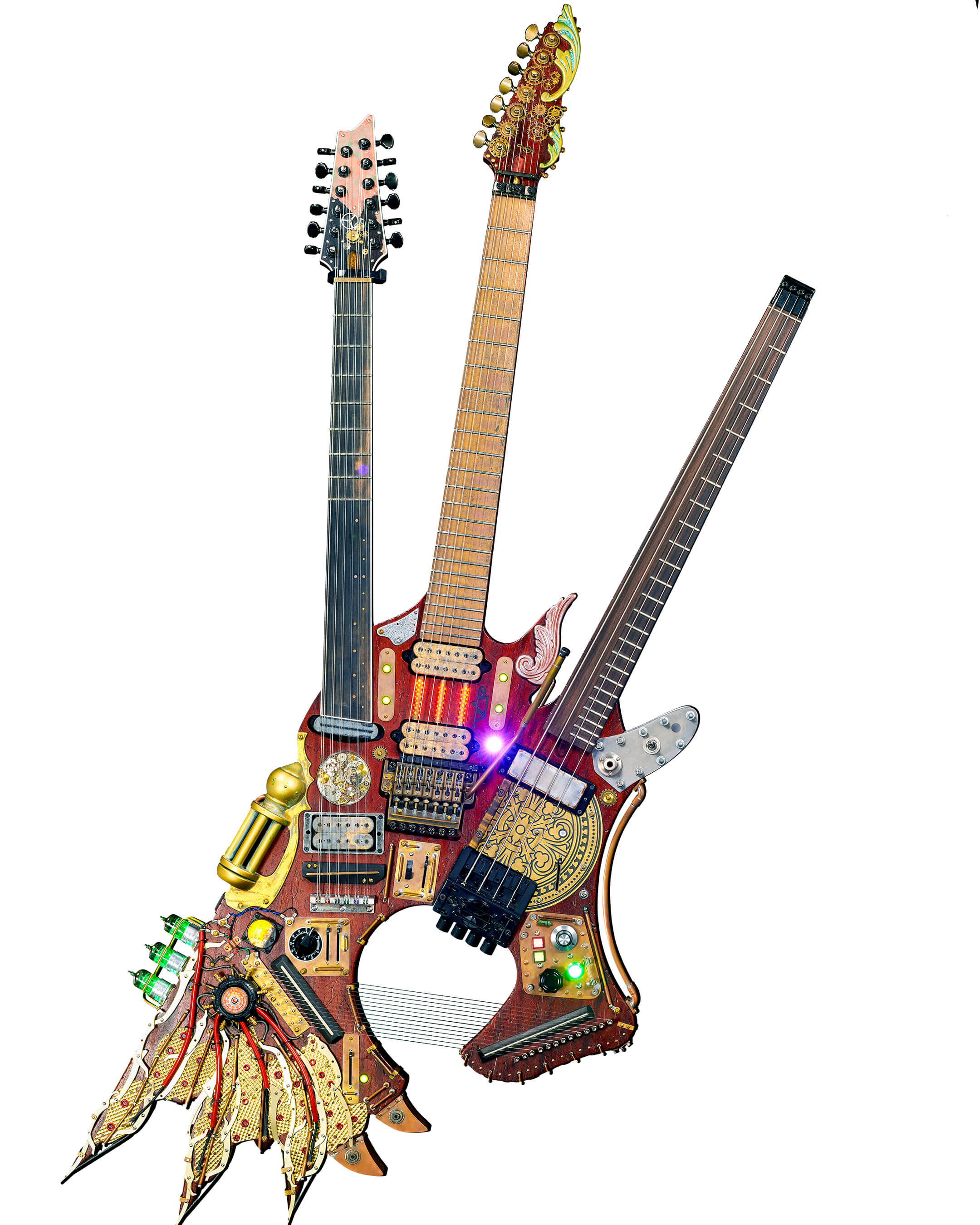“I’ve never even scratched the surface of the guitar’s potential”: Steve Vai on why new album Inviolate pushed him out of his comfort zone
There’s an argument that nobody has done more to push the boundaries of what guitar is capable of in the last 40 years than Steve Vai. But despite his name being a byword for virtuosity, the guitarist refuses to rest on his laurels. We caught up with the man himself to talk surgery, embracing what is, designing insane triple-necked guitars with Ibanez, and why one of Inviolate’s solos pushed him so far out of his comfort zone he might never be able to top it.

Image: Larry DiMarzio
For a man who has seen the best laid plans for two albums torn up by forces outside of his control in the last 18 months, Steve Vai is a remarkably positive and optimistic presence. When the pandemic originally put paid to his plan to finally complete the third and final part of his 15-year Real Illusions project, the 61-year-old shred icon looked at what he could accomplish at his home studio, and decided to finally indulge his long-held desire to make an acoustic album. Things were going swimmingly, 15 songs were written, and he was getting himself physically in shape to handle a particularly tricky strumming section when three tendons in his right shoulder went snap, requiring a surgical repair that put his picking arm in a sling.
“I try to look at everything that happens as being in my best interest,” Vai tells us via Zoom from his home studio. “I didn’t know what I was gonna do, but plans change. I didn’t always do this. I used to complain and worry quite a bit, but over the years, you just realise that when you figure it out as you go, everything’s easy. Because what are you going to do, fight what is?”
Some people might take your arm self-destructing as a sign that maybe, after a 40-year career, it was time to take it easy, but nothing could have been further from the truth. “I had my arm in this sling that was invented by the doctor that did the surgery, his name is Dr Knapp, and it’s called the Knappsack of course,” Vai chuckles. “But then shortly after the surgery, I received this beautiful Black Onyx PIA [Vai’s latest Ibanez signature model], and I’m sitting there thinking, ‘Well, I got one hand, what can I do?’ Why can’t I do a song with one hand? Anybody with a legato technique can figure that out. So I came up with something, and when I released the song – called Knappsack – I was so surprised that the response, it was really a stunner. So there was an opportunity where lemonade was made out of lemons.”
The response to Knapsack lit a fire under Vai and the result is Inviolate, his first studio album in five years. “Vai describes it as a “good vibe instrumental record” but that might be underselling things somewhat, as over the album’s tight nine tracks, the shred icon pushes his boundaries in ways he never has before.
Visual Dictionary
This is never more evident than on Candlepower, a track created over lockdown that saw Vai develop a new technique where you where you bend a note while fretting another but bending only the top joint of the finger independently from any other finger, which he has christened, “joint shifting”. It’s a remarkable thing to see and hear, but Vai doesn’t seem to be basking in his new creation. “The lockdown gave me a lot of time to fool around with some techniques and things that I had in the back of my head,” he shrugs.
If you think it’s remarkable that someone who has spent four decades being hailed as the archetype and the pinnacle of shred guitar can still happen upon a way of playing that he’s never thought of before, you’re not alone, but Vai is quick to challenge that notion. “I’ve never even scratched the surface of what the potential of that instrument is,” he insists. “All of us do that, together, y’know? But it’s very interesting, because I don’t think about, ‘What are you going to do next?’ I’ve just been blessed every step of the way.
“I know how weird I come off to some people. It used to bug me. But then you just realise, ‘Who needs to be the happy one here?’ Why fight yourself?”
“So what I do is, I just think, what would I like to do? I have a very simple technique for creation that anyone can use. You have to know the fact, first and foremost, that you are a creative person. You don’t believe so? You’re being misled by your own self. Because you are, that’s what you’re here for. Being creative is the gift that everybody has – but many people block it because of insecurities or fear of failure, or whatever it is. The ability to be creative is infinite – you’ll never tap it out. The only thing that can ever obstruct it is your belief that it’s not there.
“So I know it’s there, what I don’t know is how it’s gonna show itself. But I just say, ‘Okay, I would like something fun, something cool’. I always tell myself, ‘Okay, now you’re going to do something that you never did before’. Because why not? And then inevitably an idea, an inspiration, just comes in one download. So with Candlepower it was like, ‘You’re gonna play a guitar clean, with no whammy bar, with your fingers and you’re gonna do this technique – and the whole thing just came! Boom! Okay, I’m gonna do it. Got it!
“And it seems impossible. I’ll sit there at first, and you visualise it and it’s like, ‘What was I thinking?’ It almost seems overwhelming. And then you just start, you just do it. And then it’s not overwhelming anymore.”

Gretsch Appeal
This spirit of diving in head-first into the unknown is all over Inviolate, and that’s perhaps never more the case on Little Pretty – a track that sees Steve Vai, yes that Steve Vai, using that most un-shred of instruments: a Gretsch.
“It’s just sound of it,” Vai enthuses when we ask him what on earth he was thinking. “Because a Gretsch like that, nothing sounds like it. The notes have space around them. I had the riff for Little Pretty, and I realised that I just couldn’t just use my humbucker JEMs, because that’s just too much. They’re too big, it’s a different kind of sound.
“So I had that guitar and I would walk past it in the studio for like, five years like, ‘One day I’m going to play you!’ Then when I had the riff for a Little Pretty I said, ‘Now’s the time’ and I picked up the guitar and I went to play… but then I realised there was no way I was going to be able to do what I was envisioning on that guitar. So I sent it to a friend of mine who really knows how to make an unplayable guitar playable. But as playable as that guitar became, it was still outside of my comfort zone, especially when I was playing something like Little Pretty where there was no compensating for anything.
A demanding and outside the comfort zone experience it may have been, but it was a hugely rewarding one – even given an artist’s tendency to enthuse about their most recent work, Vai’s appraisal of it demands attention.
“The solo on Little Pretty, that’s a monumental achievement for me – that’s one of my best ever,” he reflects. “I can’t touch that, I mean it. When I set out to do that, I said, ‘You’re gonna write chord changes that are unlike anything you’ve ever heard. Every chord is going to be different. It’s going to reflect a synthetic mode that you’ve never played, and it’s going to go by fast, and you’re going to solo over it and you are not going to sound like a jazz-bo fusion-head! You’re going to sound like you’re creating a motherfucker of a melody over impossible chords… oh and it’s going to sound easy!’”

and much more. Image: Larry DiMarzio
Hail Hydra
If easy was in Steve Vai’s vocabulary, then we probably wouldn’t have the album’s opening track, The Teeth of The Hydra, a dazzling melodic piece created to showcase the absolutely insane guitar that inspired it, which he’s holding on the album’s cover. The Hydra is a gloriously mad idea – a triple-necked guitar/bass with sympathetic harp strings, and dizzying array of in-built technology, all wrapped up in a gloriously steampunk finish. It’s like something out of a movie, and in this case with good cause.
“The Hydra started when I was watching one of the Mad Max movies,” Vai explains. “There’s this thing where they’re driving through the desert, and there’s this guy on the front of a truck with a guitar. And I thought that was so cool. I thought, ‘Man, I want a piece of that! I’m doing something like that!’
“So the idea that came was to create an instrument that was kind of unique, where it had three necks – one neck was a 12-string, with half of it being fretless, a seven-string neck, and then a bass neck with the E and A strings fretless… and then it’s got these harp strings on it.

“And I got with Ibanez, and I shared everything… and I gotta tell you, man, these guys, they just blew up the bridge! This was about five years ago when it started, and they sent me a rendition of the Hydra that just stunned me, I couldn’t believe it, it was more than I expected. And I’m like, ‘You… you’re gonna build that!? Really?!’ We’re gonna build it.” Over the next four or five years, Vai would go back and forth with the boffins at Hoshino Gakki in Japan – Moti Kashiuchi who created the original render, and luthier Kazuya Kuroki and engineer Hirotada Nomura who brought the instrument to life – honing the design through several prototypes until it was ready.
“Maybe a year and a half ago, it shows up in the studio and I couldn’t believe it when I saw it. It was awesome and intimidating,” Vai recalls. “Because I knew when I had the original idea, when the download came, one of the rules I give myself is it doesn’t matter if it’s weird or quirky – it has to sound like a piece of music and it has to have melody. If it has no melody, it’s just wank. Because it’s not a gimmick, this guitar. It’s got piezos, and sustainers and sympathetic strings and sample-hold stuff – the technology they put into this instrument is stunning.”

So you’ve spent five years crafting this insane triple-necked behemoth that you want to use to create something musically exciting… but before you can do that you need to answer a very question – how do you even play the damn thing?
“Imagine what it would be like to juggle chainsaws!” he chuckles. “I just knew I wanted it to look fascinating. Because I’m a performer, you know, I’m a ham! I love theatre and all this stuff. I’m an entertainer… but the Hydra is very heavy, and we didn’t really consider that! So we designed this waist strap, so all the weight is on my waist and not on my shoulders. But still, it’s heavy, and when you’re holding it, it almost feels like you have vertigo, it takes you where it wants you to go. It’s laid out in a way that’s very playable, but you can’t stand with it for more than five minutes, and I needed to use it for six weeks. So we propped it up, and then I sat there for six weeks!
“The funny thing is, when I first got there, and I’m looking at this thing, and I’m like, ‘How are you going to do this? What were you thinking? You got some balls Vai! Are you really going to do this?’ And then there’s the fear, you know. Thinking, ‘I’ve got this instrument and it’s really cool, but people are gonna see and just think it’s a novelty, and I had it made because I can, because I’m Steve Vai and I can have anything made!’ So I’ve got to deliver. And I’m sitting there going, ‘But how are you going to deliver?!’ And inevitably there’s always a little voice of fear in the background, but inevitably, there’s this other voice that always comes in and says, ‘Shut the fuck up. Just do it. You got this.’ That little voice is probably at the foundation of everybody’s creative impulse when it comes time to eclipse any fear that you have about doing it. So I’m like, ‘Yes, sir!’”
The Greatest Showman
Those who remember the Ultra Zone will be aware that this far from the first time in his career that Vai has indulged his flair for the theatrical and vaguely preposterous – for many of us, that’s part of the fun of instrumental guitar, particularly in a live setting. When we ask Vai if he sees such theatricality as being part of the job for someone like him, he’s quick to counter.
“I don’t see it as a job,” he insists. “I see it as my particular way of expressing what I like to do. For instance, I was watching this video of Derek Trucks, and that guy is a completely inspired player – I loved it. And he barely moves at all. He just plays so beautifully, and that’s the way he does it. I wouldn’t speak for him, but I would assume that there’s probably not a big, ‘I am an entertainer, and need to project to the end of the arena’. attitude. It’s like, here I am, and that’s it. And that’s great, for him, but I’ve always had a little different approach, maybe a big different approach!
“I am the champion of my music, every artist is – why wouldn’t I be? Don’t make it unless it’s important to you”
“I don’t know why, it’s just something that was in me from the very, very beginning. And I fought it for many years, because I know how peculiar it can look, you know, I know how weird I come off to some people. It used to bug me to see criticisms and stuff. But then you just realise, ‘Who needs to be that happy one here?’ Why fight yourself? And this is a great message for any guitarist, or anybody that feels as though their creative impulses are not the norm, what ever the fuck that means! I surrendered to myself.”
It’s strange to hear one of guitar’s most consistent innovators speak about the insecurities that come along with being a trailblazer and following your muse, but it’s important to remember quite how different the landscape was when he first came onto the scene. Nowadays it’s de rigueur for an artist to attend Berklee or any of the scores of other prestigious guitar schools across the world to hone their craft, but when Vai attended in the late 70s?
“I looked for music colleges that had guitar, there weren’t any! Berkeley was the only one!” he laughs. “When I started going, it was nothing like today – it was the only school that had guitar, and it was jazz, because besides classical music, that was the other acceptable genre!
“As a matter of fact, I was once coerced by a band member to learn cover songs so that we could actually make some money. So we were rehearsing playing Kansas and all this progressive rock stuff, but we would have to put a sheet over the window where we were on campus, so that nobody would know who was playing that devil rock ‘n’ roll!”

Hot For Teaching
While by his own admission Vai spent most of the 90s focussing on building his career as a performer, in recent years he’s devoted more and more of his time to sharing his vast knowledge with the next generation, whether that’s through his Alien Guitar Secrets clinics, his Truefire course, or most recently via his Patreon page.
“You know, when I was in high school and I was studying music theory, while I had these fantasies of being a rock musician, a part of me felt that I would be very happy as a high school music teacher,” Vai says. “Because my high school music teacher changed the quality of my life, you know? He gave me such great gifts. And I thought, I can do that for others.
“Now one of my goals is to create some kind of a forum where everything that I’ve learned, everything that might be helpful to young players, or anybody, I want to put everything there. We looked at various ways of presenting it, and in the discussion it was brought to me that Patreon would probably be the best way. It’s been working really well and I just keep putting stuff in it – hopefully, maybe someday, that’ll quench my teaching desires!”
For a man in his 60s, Vai is clearly very engaged with social media and the modern innovations that have to a large extent democratised music and made it easier to build an audience than ever before – albeit with their own sets of pitfalls.

“Like anybody else that comes along, whenever they come along, they only have the tools at their disposal that’s available to do what they do,” he says. “And for me, that was things like a cassette recorder, and then a four-track recorder. How do you get it out? There was no way! I mean, there was no digital, there were no emails, there was no internet. When my first record came out, The Attitude Song was put in Guitar Player magazine as a flexi-disc. And that was the best we had!
“So you adjust, and these days I don’t do it like I used to do it. I’m going to use everything that’s available to me. That’s one of the things that I noticed with a lot of young artists that are wondering how to get their music, usually they say, ‘How do you do it?’ And then they fill in the blank by complaining in their head. Like, ‘Why should I do it? What, good is it to put your music out when everybody gets it for free? Labels aren’t signing my kind of music…’
“There’s other ways to look at it. And one of the ways is, that technology is your friend – technology is there to help you. Everybody in this business is there for you and you are there for them, you just gotta navigate to the right people, and they will serve you very well, and you will serve them. Technology has made it so that I don’t have to answer to a label or anything – nobody is controlling my creative desires, except me.”
Go Your Own Way
Whether you first cottoned on to him as Frank Zappa’s stunt guitarist, dug his work with David Lee Roth, or were mesmerized by the game-changing Passion And Warfare, Steve Vai has for many of us been synonymous with the pinnacle of what our instrument can achieve, both technically and creatively, for our entire lives. As we wrap up our chat, we wonder how he’s stayed on the bleeding edge for so long.
“I’ve always turned a blind eye to what was supposed to be the most ‘successful’ course for me in the world, because you don’t know what that is,” Vai explains. “So when it comes time to create a piece of music, I always try to infuse it with something that really pushes my buttons. Something that says, ‘Okay, you’ve never done this before’. And that’s what turns me on. I love that– when I have a creative idea for something, and then I just do it.
“This is a lesson I’ve learned that can be useful for anyone. The moment you decide ‘I’m going to do this’, the sun, the moon and the stars will work with you – it has to happen! But you have to authentically and sincerely decide, ‘I’m going to do this’.
If it sounds like I’m speaking as though everything I do is great – no! I read this article about a month ago, and the guy was talking about this DJ, and he said, ‘This DJ is like Steve Vai, in that he believes that everything he does is much deeper than it actually is.’ And I sat and I thought about that, and I thought, ‘Yeah, he’s right!’
“I am the champion of my music, and every artist is the champion of their music – why wouldn’t I be? Don’t make it unless it’s important to you and it’s as deep as you can go. And if I’m not as deep as everyone else? I can assure you that I’m doing the very best I can, and that’s all anyone can do!”
Inviolate is out 28 January 2022 via Mascot Label Group.




